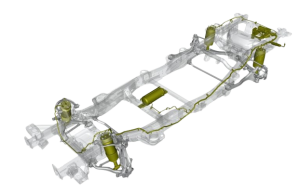When it comes to modern vehicles, the subtle yet profound impact of suspension systems cannot be overstated. Two leading technologies that have risen to prominence in the realm of automotive engineering are Air Ride Adaptive Suspension and Magnetic Ride Control. Each system possesses unique characteristics, advantages, and applications, making them suited to different driving styles and preferences. As drivers increasingly seek optimized comfort and performance, understanding the nuances of these technologies is essential.
Understanding Suspension Systems
The suspension system plays a crucial role in a vehicle’s stability, handling, and ride quality. Essentially, it connects the vehicle body to its wheels, allowing for smooth interactions with various terrains. Without an effective suspension, the driving experience would be jarring, with excessive vibrations and poor handling impairing safety and comfort. The Air Ride Adaptive Suspension and Magnetic Ride Control represent the vanguard of suspension technology, each with its distinctive merits.
Air Ride Adaptive Suspension Explained
Air Ride Adaptive Suspension utilizes compressed air to adjust the height and stiffness of a vehicle’s suspension. This system is particularly advantageous for larger vehicles, such as SUVs and trucks, where varying loads may affect ride height. Essentially, it incorporates air springs that can inflate or deflate variably, providing real-time adjustments that adapt to the road conditions.
One of the standout benefits of this system is its ability to maintain consistent ride height regardless of the payload. Whether you’re driving solo or transporting a heavy load, Air Ride ensures that the vehicle maintains optimal ground clearance. This feature not only enhances ride comfort but also bolsters vehicle safety by preserving the integrity of the vehicle’s balance and traction.
Additionally, with integrated air management technology, drivers can fine-tune their vehicle’s suspension settings according to specific requirements. Adaptive modes may include settings geared towards fuel efficiency, off-road maneuvers, or a more dynamic driving experience. This versatility adds a layer of customization that appeals to various driving styles.
Magnetic Ride Control Unveiled
Magnetic Ride Control, on the other hand, offers a cutting-edge approach by using advanced magnetorheological fluid within the shock absorbers. This fluid changes its viscosity when exposed to a magnetic field, allowing for instant adjustments to the firmness of the shocks. By employing sensors that gauge road conditions and driving behavior, this technology assures rapid adaptations to the suspension setup, typically within milliseconds.
The responsiveness of Magnetic Ride Control is one of its most compelling attributes. This system boasts exceptional precision in handling, contributing to superior cornering ability and stability during high-speed maneuvers. If you’re the kind of driver who thrives on engaging performance, Magnetic Ride may be the ideal choice. It almost feels as if the vehicle is reading the road ahead, adapting seamlessly to ensure an exhilarating driving experience.
Moreover, Magnetic Ride Control often incorporates selectable driving modes, empowering drivers to tailor their experience further. Whether navigating city streets or expansive highways, the suspension remains adept and flexible—providing a ride that is as comfortable as it is exhilarating.
Side-by-Side Comparison
When comparing Air Ride Adaptive Suspension and Magnetic Ride Control, it’s paramount to consider several factors. Each technology exudes its strengths, and understanding these can influence the ultimate decision for many automotive enthusiasts.
- Comfort vs. Performance: Air Ride excels in delivering unparalleled comfort, particularly when dealing with varying loads. Conversely, Magnetic Ride is tailored more for performance-oriented driving, prioritizing feedback and cornering stability.
- Customization: Both systems offer adjustable settings, but Air Ride’s focus on ride height adjustments provides a unique capability, especially for off-road enthusiasts. Magnetic Ride’s instantaneous response time, however, appeals to those seeking a sportier driving experience.
- Maintenance Considerations: Air Ride systems may require more frequent maintenance due to potential leaks in air lines. In contrast, while Magnetic Ride’s fluid technology provides great performance, it necessitates occasional fluid replacement for optimal function.
- Cost Implications: Investing in either system can be significant. Generally, Magnetic Ride Control is integrated into luxury performance vehicles and may carry a higher upfront investment compared to Air Ride, which is prevalent in a broader range of vehicles.
Which One is Right for You?
In conclusion, selecting between Air Ride Adaptive Suspension and Magnetic Ride Control ultimately hinges on personal preferences and driving needs. If your priorities are comfort and the capability of handling heavy loads seamlessly, Air Ride will serve you well. However, if spirited driving and precision handling are paramount, Magnetic Ride’s scientific prowess offers compelling advantages.
Ultimately, it’s not merely about the technology; it’s about the driving experience it cultivates. The road beckons, and with your choice in suspension systems, a world of adventure awaits.
